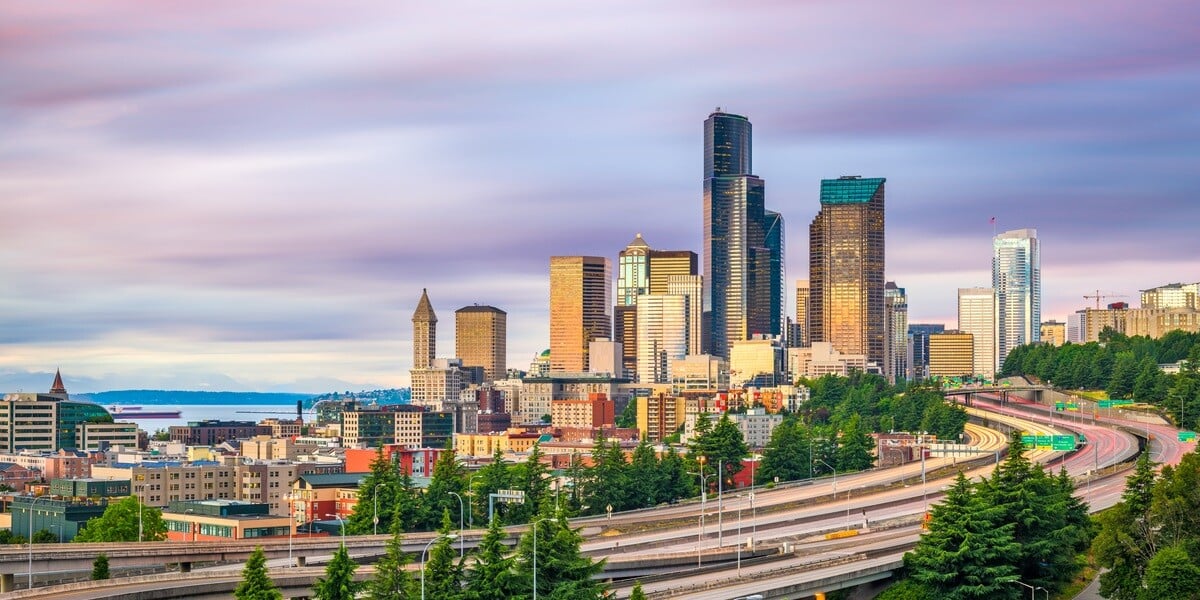South Lake Union’s transformation — largely fueled by the growth of its highest-profile employer, Amazon — has had a ripple effect that’s reshaped the surrounding city, for better or worse.
It’s all happened so quickly.
You don’t have to be a lifelong Seattleite to remember the old, down-at-heel South Lake Union of the 1990s — less a neighborhood than a patchwork of parking lots, warehouses and low-slung industrial buildings. It felt like a ghost town, even at midday.
No more.
Today, 36,000 people work in the neighborhood, almost a 50 percent jump just since 2009, the year before Amazon relocated its headquarters here from Beacon Hill. At the corner of Westlake and Denny — where Whole Foods opened in 2006 — the number of pedestrians nearly quadrupled in just five years, according to counts conducted by the Downtown Seattle Association. At peak time, 1,711 people cross there every hour — their faces buried in their phones, no doubt.
On a stroll down Westlake Avenue, you can shop for swank home goods at West Elm, dine at Tom Douglas’ upscale pizza parlor or even splurge on an electro-luxury car at the Tesla showroom.
Is South Lake Union the fastest-changing urban neighborhood in America?
It’s certainly a contender. True, there are a few other big city neighborhoods that have seemingly sprung up overnight recently: San Francisco’s Mission Bay, Boston’s Seaport District and New York’s Hudson Square come to mind.
But South Lake Union is unique. Its transformation — largely fueled by the growth of its highest-profile employer, Amazon — has had a ripple effect that’s reshaped the surrounding city, for better or worse.
The amount of development has been staggering. “More than 50 new buildings in the last decade,” says Ethan Phelps-Goodman, who runs the construction-tracking website Seattle In Progress. “That’s just about doubled the total commercial square footage in the neighborhood.”
So much of South Lake Union is sleek and new, it’s not surprising that it’s been derided as “soulless.” All the gleaming glass buildings have an architectural sameness. Even though it has become a major job center, it’s true that the neighborhood doesn’t quite feel lived-in yet.
But that’s also changing rapidly. Census data shows close to 7,000 residents in South Lake Union and the Denny Triangle area in 2014, up from 1,500 in 2000 — a rate of growth that leaves every other Seattle neighborhood in the dust.
The eastern half of South Lake Union — folks used to call it Cascade — was once a low-rent area, but new luxury-apartment complexes have transformed it into an upscale address.
Census data shows that the median rent paid by residents increased 26 percent between 2009 and 2014 — and that’s after adjusting for inflation. The median listing price for a one-bedroom apartment is $1,950, according to Zillow.
But as dramatic as the changes have been, you ain’t seen nothin’ yet.
Get ready for skyscrapers.
According to Ethan Phelps-Goodman, high-rise towers up to 42 stories tall will further change the face of South Lake Union over the next few years: “With 16 different towers in the planning stages, we’re likely to see the residential and commercial capacity of the neighborhood double yet again.”
South Lake Union’s transformation — largely fueled by the growth of its highest-profile employer, Amazon — has had a ripple effect that’s reshaped the surrounding city, for better or worse.
It’s all happened so quickly.
You don’t have to be a lifelong Seattleite to remember the old, down-at-heel South Lake Union of the 1990s — less a neighborhood than a patchwork of parking lots, warehouses and low-slung industrial buildings. It felt like a ghost town, even at midday.
No more.
Today, 36,000 people work in the neighborhood, almost a 50 percent jump just since 2009, the year before Amazon relocated its headquarters here from Beacon Hill. At the corner of Westlake and Denny — where Whole Foods opened in 2006 — the number of pedestrians nearly quadrupled in just five years, according to counts conducted by the Downtown Seattle Association. At peak time, 1,711 people cross there every hour — their faces buried in their phones, no doubt.
On a stroll down Westlake Avenue, you can shop for swank home goods at West Elm, dine at Tom Douglas’ upscale pizza parlor or even splurge on an electro-luxury car at the Tesla showroom.
Is South Lake Union the fastest-changing urban neighborhood in America?
It’s certainly a contender. True, there are a few other big city neighborhoods that have seemingly sprung up overnight recently: San Francisco’s Mission Bay, Boston’s Seaport District and New York’s Hudson Square come to mind.
But South Lake Union is unique. Its transformation — largely fueled by the growth of its highest-profile employer, Amazon — has had a ripple effect that’s reshaped the surrounding city, for better or worse.
The amount of development has been staggering. “More than 50 new buildings in the last decade,” says Ethan Phelps-Goodman, who runs the construction-tracking website Seattle In Progress. “That’s just about doubled the total commercial square footage in the neighborhood.”
So much of South Lake Union is sleek and new, it’s not surprising that it’s been derided as “soulless.” All the gleaming glass buildings have an architectural sameness. Even though it has become a major job center, it’s true that the neighborhood doesn’t quite feel lived-in yet.
But that’s also changing rapidly. Census data shows close to 7,000 residents in South Lake Union and the Denny Triangle area in 2014, up from 1,500 in 2000 — a rate of growth that leaves every other Seattle neighborhood in the dust.
The eastern half of South Lake Union — folks used to call it Cascade — was once a low-rent area, but new luxury-apartment complexes have transformed it into an upscale address.
Census data shows that the median rent paid by residents increased 26 percent between 2009 and 2014 — and that’s after adjusting for inflation. The median listing price for a one-bedroom apartment is $1,950, according to Zillow.
But as dramatic as the changes have been, you ain’t seen nothin’ yet.
Get ready for skyscrapers.
According to Ethan Phelps-Goodman, high-rise towers up to 42 stories tall will further change the face of South Lake Union over the next few years: “With 16 different towers in the planning stages, we’re likely to see the residential and commercial capacity of the neighborhood double yet again.”






